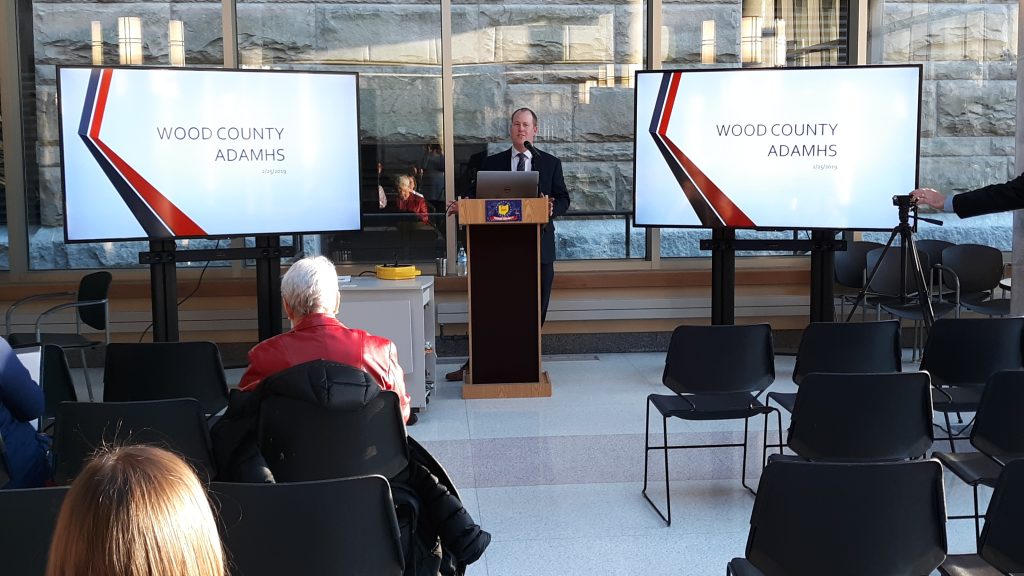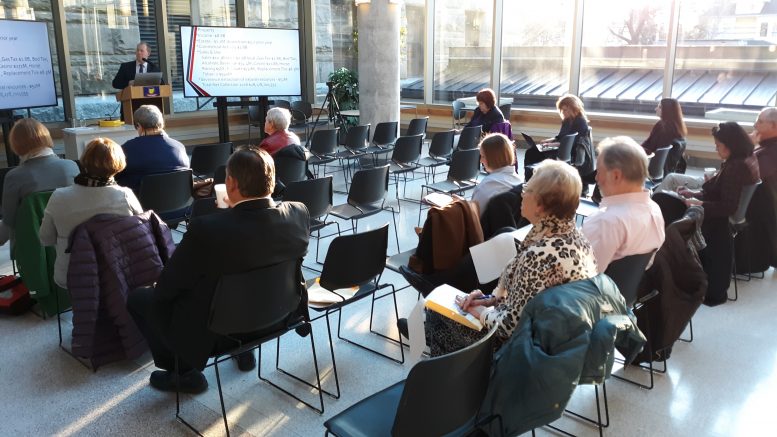By JAN LARSON McLAUGHLIN
BG Independent News
About halfway through his presentation on tax levies, Wood County Auditor Matthew Oestreich checked on his audience.
“Anybody awake out there,” he asked.
It was no reflection on Oestreich – but purely on the topic.
Oestreich was asked to talk Monday evening about local levies to the Wood County Alcohol, Drug Addiction and Mental Health Services Board. He started out broad, noting that Ohio ranks 25th among the states for per capita local and state taxation, at $4,414 a year. North Dakota comes in at the highest, at $9,182 per person per year, and Alabama is the lowest at $3,141 per person a year.
Ohio collects the following ballpark estimates in various taxes:
- Sales tax – $10.3 billion.
- Gas tax – $1.8 billion.
- Bed tax and alcoholic beverage tax – $54.4 million.
- Casino tax – $272 million.
- Horse racing tax – $5 million.
- Kilowatt tax – $537 million.
- Replacement tire tax – $8.5 million.
- Tobacco tax – $940 million.
Back home in Wood County, there are 83 different taxing districts, with 402 individual levies currently in place.
Property taxes are the oldest tax in Ohio, first collected in 1825, Oestreich said.
Appraisals are conducted by county auditors every six years, with updates done every three years. Oestreich covered the basics – explaining that market value is the price that a motivated buyer and seller would arrive at, while the assessed value is 35 percent of that market value.
In 2016, the assessed value in Ohio added up to $238.3 billion. That same year, Wood County’s assessed value totaled $3.263 billion.
Wood County last performed it reappraisal of approximately 75,000 parcels in 2017. The next will be done in 2023.

The county tax base can be divided into the following types of properties:
- Agricultural – $345 million, 10 percent of the tax base.
- Residential – $2,059 million, 61 percent of the tax base.
- Mineral – $61,840, which is 0.002 percent of the tax base.
- Industrial – $192 million, 6 percent of the tax base.
- Commercial – $528 million, 16 percent of the tax base.
- Real public utility – $3.8 million, which is 0.1 percent of the tax base.
- Personal property public utility – $239 million, 7 percent of the tax base.
Oestreich explained how the Current Agricultural Use Value works. Land devoted exclusively to commercial agricultural use may be valued based on its current use, instead of its “highest and best” potential use.
The CAUV program is a substantial savings for farmers, he said.
“There are probably no farms in the county not in the program, because the savings are big,” Oestreich said.
The highest residential/agricultural tax rate in Wood County is in the taxing district covering Perrysburg Township and Rossford City in the Rossford School District. The lowest residential-agricultural rate is in the Jackson Township area in the McComb School District. The wide ranging rates in those two areas account for a difference of $1,643 in taxes on a $100,000 home, Oestreich said.
The county auditor also addressed the pipelines recently constructed in Wood County that are bringing in some welcome tax revenue. The Rover pipeline that runs through the southern portion of Wood County has resulted in $4.2 million coming in countywide – replacing Toledo Edison as the biggest taxpayer in the county.
Generation pipeline in the northern part of the county has brought in $1 million in tax revenue for the county.
And next year, the Nexus pipeline north of Bowling Green, and the second Rover pipeline are expected to be in operation and paying taxes.
“These values are very substantial now,” Oestreich said. “Over time, the value will start to deteriorate.”


